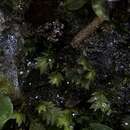zh-TW
在導航的名稱


Fissidens celticus, also known by its common name Welsh pocket-moss, is a species of moss in the family Fissidentaceae. It was discovered in 1958 in Pembrokeshire by A.H. Norkett and was first described as a new species by Jean Paton in 1965.[3]
Fissidens celticus has shoots up to 4.5 millimetres (0.18 in) tall and 1–1.5 millimetres (0.039–0.059 in) wide.[4] Each shoot has many leaves, often 10 pairs or more, of equal size.[4] The nerve in each leaf runs all the way to the leaf tip and has a distinct bend about halfway along the leaf.[4] Male plants and capsules are not known,[5] and it is uncertain how the species disperses.[6]
Fissidens celticus can be distinguished from F. exilis by its longer shoots, its greater number of leaves and its lack of capsules.[4]
Fissidens celticus grows on shaded soil banks near woodland streams, especially on bare, compact patches eroded by floodwater.[4] It has an altitude range of between 5 and 300 metres (16.4 and 984 feet).[3]
Fissidens celticus is generally believed to be widespread and common within suitable localities. It is apparently endemic to western Europe and there is no evidence of population decline.[1]
The species holotype was from Hustyn Wood, St Breock, Cornwall,[6] and it is common throughout the western parts of the United Kingdom.[3] In the United Kingdom, F. celticus often associates with Calypogeia arguta,[3] Diplophyllum albicans,[3] Dicranella heteromalla,[6] Dicranella rufescens,[3][7] Epipterygium tozeri,[3] F. bryoides,[3] Pellia epiphylla,[3] Pohlia lutescens,[3] and Pseudotaxiphyllum elegans.[3]
Fissidens celticus is most commonly found in South West England, but is also present in the south east and north west.[3]
There are records of F. celticus from Cornwall,[6] Devon,[8] Gloucestershire,[9] Kent,[10] and Sussex.[11] On the Isle of Wight, it is present in Parkhurst Forest,[12] and at Briddlesford Nature Reserve.[13] As of 2001, the only known record in Lancashire was on the River Lune Biological Heritage Site.[14]
The species can be found all across western Wales,[3][15] including on Anglesey.[16]
Fissidens celticus is present in much of western Scotland.[3] The Tayvallich Juniper and Fen SSSI (near Tayvallich, Argyll and Bute) is noted for its oceanic bryophytes, including F. celticus.[17]
In Northern Ireland, the only known location for F. celticus is in Ness Wood ASSI in County Londonderry.[18]
Fissidens celticus has been recorded in many other countries in Europe:
In 2019, it was first reported in Turkey (and therefore in Asia).[22] It was found in Bozyazı, Mersin Province, associating with Bartramia stricta, Bryum dichotomum, Didymodon tophaceus, Targionia hypophylla and Timmiella barbuloides.[22]
Fissidens celticus, also known by its common name Welsh pocket-moss, is a species of moss in the family Fissidentaceae. It was discovered in 1958 in Pembrokeshire by A.H. Norkett and was first described as a new species by Jean Paton in 1965.
Fissidens celticus là một loài Rêu trong họ Fissidentaceae. Loài này được Paton mô tả khoa học đầu tiên năm 1965.[1]
Fissidens celticus là một loài Rêu trong họ Fissidentaceae. Loài này được Paton mô tả khoa học đầu tiên năm 1965.